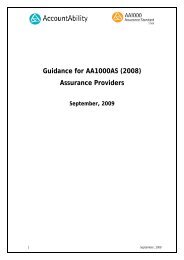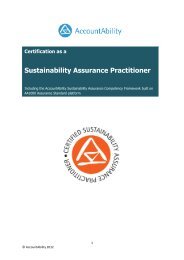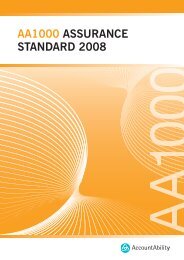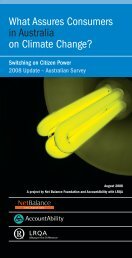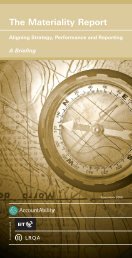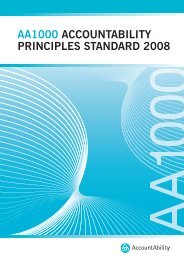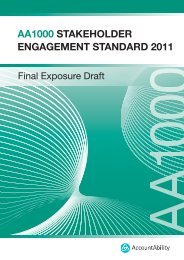The Stakeholder Engagement Manual Volume 2 - AccountAbility
The Stakeholder Engagement Manual Volume 2 - AccountAbility
The Stakeholder Engagement Manual Volume 2 - AccountAbility
Create successful ePaper yourself
Turn your PDF publications into a flip-book with our unique Google optimized e-Paper software.
SUMMARY TEMPLATE T5:<br />
ASSESSMENT OF ORGANISATIONAL ABILITY TO RESPOND TO AN ISSUE*<br />
Prioritised Issue:<br />
Social maturity of the issue:<br />
Latent<br />
Enabler<br />
Governance and<br />
management<br />
commitment to issue<br />
Policy regarding the<br />
issue<br />
Current engagement<br />
activities regarding<br />
the issue<br />
Performance<br />
indicators/<br />
measurements<br />
regarding the issue<br />
Internal<br />
responsibility and<br />
competency to<br />
address the issue<br />
Review and learning<br />
processes in regards<br />
to the issue<br />
Possible levels of action<br />
1. Formal commitments in place with responsibility at board level.<br />
2. Formal commitments with responsibility at senior management level<br />
3. Formal statement or policies made but no formal responsibility at senior levels.<br />
4. Action to address issue driven by individual commitment and awareness.<br />
5. No awareness/action.<br />
Give details: __________________________________________________________<br />
1. Formal policy with objectives that are linked to business strategy.<br />
2. Formal policy with objectives that are not linked to business strategy.<br />
3. Draft or holding policy but no objectives.<br />
4. Early discussions about policy.<br />
5. No policy.<br />
Give details: __________________________________________________________<br />
1. Formalised and integrated into management and governance processes with robust documentation and<br />
reporting systems.<br />
2. Systematised engagement approach with documentation and some linkage into decision making processes.<br />
3. Established engagement processes for some relevant stakeholders/ issues.<br />
4. Sporadic engagement processes, limited internal controls.<br />
5. No engagement.<br />
Give details: __________________________________________________________<br />
1. Strategic objectives and SMART Key Performance Indicators (KPIs) set in order to meet management and<br />
stakeholders’ information needs. Internal and external reporting and assurance mechanisms in place.<br />
2. KPIs that respond only to internal management needs, internal reporting with little or no assurance.<br />
3. KPIs that only partially meet stakeholder information needs.<br />
4. Early discussions relating to development of KPIs and monitoring.<br />
5. No objectives set, no Key Performance Indicators.<br />
Give details: __________________________________________________________<br />
STAGE 2<br />
Emerging Consolidated Institutionalised<br />
1. Issue related targets form part of the performance reviews of individuals, and are considered when deciding<br />
on potential performance rewards.<br />
2. Required competencies are addressed in recruitment and training, and considered in the rewarding of performance.<br />
3. Responsibilities assigned but no formal mechanisms to reward, recruit or train to ensure required competency.<br />
4. Early discussions relating to assignment of responsibilities and understanding of necessary competencies.<br />
5. No internal responsibility considered for this issue/ stakeholder<br />
Give details: __________________________________________________________<br />
1. Continuous review and learning to innovate and adapt organisational policy and processes, with learning<br />
from engagements feeding into the organisation’s strategic decision making.<br />
2. Review and learning processes generate limited changes relating to specifi c issues and departmental<br />
functions. Organisational change management is starting to establish links with stakeholder analysis.<br />
3. Ad hoc review and learning processes leading to incremental changes.<br />
4. Review and learning processes driven and limited to individuals.<br />
5. No stakeholder engagement happening on this issue.<br />
Give details: __________________________________________________________<br />
Overall adequacy of your ability to respond / areas which require improvement:<br />
Which improvements are required in the 6 areas (rows) given above?<br />
(Example 1: re Performance measurements and indicators: “KPIs that provide internal guidance to managing the issue need to be developed.”)<br />
(Example 2: re Review and learning processes: “Need to establish continuous review and learning processes so that we can adapt organisational<br />
policies and processes in response to stakeholder expectations and organisational needs.”)<br />
*electronic version downloadable at www.accountability.org.uk<br />
THE PRACTITIONER'S HANDBOOK ON STAKEHOLDER ENGAGEMENT | 55



